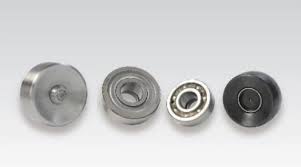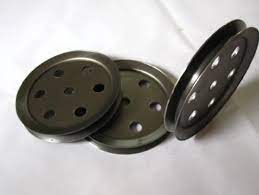Product Description
CHINAMFG Machinery specializes in power transmission components:
1. Keyless Locking Devices
2. Keyless Bushings
3. Timing Belt Pulleys
4. Jaw Couplings
5. Rigid Shaft Couplings
6. Nylon Sleeve Couplings
7. Taper (Lock) Bush
8. Shaft Collars; Fixing Collars
9. Spur Gears and other parts
10. Torque Limiters
11. Mechanical Parts made-to-order
· Ubet Keyless Locking Devices are used in rotating machinery, producing clamping pressure between surface of locking device and shaft to create adjustable and releasable mechanical connection, so as to clamp gears, pulleys and other components to a shaft without threads or keys
Materials of CHINAMFG Locking Device are available in:
Carbon Steel S45C, C45E, 1045, 40Cr, 42CrMo4V
Stainless Steel AISI431, AISI304
· Ubet Machinery Timing Belt Pulleys and Toothed Bars/ Timing Bars.
Standard and non-standard pulleys according to drawings are available.
Materials of CHINAMFG Timing Belt Pulleys are available in:
AlCuMgPb 6061 6082 Aluminum Timing Pulley
C45E 1045 S45C Carbon Steel Timing Pulley
GG25 HT250 Cast Iron Timing Pulley
SUS303 SUS304 AISI431 Stainless Steel Timing Pulley
Other material on demand, such as cooper, bronze and plastic
· Ubet Jaw couplings are designed as 3 piece combination, including 2 hubs and 1 elastomer made of polyurethane. The curved jaw fits CHINAMFG the spider, which minimizes shock to the motor and other sensitive equipment.
Material: Alluminum for size below 42
Steel for size over 42
Finish: Natural or Anodizing
Size Range: 19 to 75
Finished bore: according to ISO fit H7
Keyway width: according to DIN 6885/1
The Tolerance of keyway is Js9
| Process | Equipment | Precision Degree | Machining range |
| Blank Making | Resin bonded sand production line;Vertical parting flaskless molding line,146 opening production line;Electric furnace; CHINAMFG cupola; Guillotine shear,Punching machine; Forge rolling machine; Precision die forging machine; | precision cast; precision forging; precision molding | All sorts of casting and forging parts |
| Heat Treatment | Vertical furnace; Speckled furnace;High frequency quenching furnace | Material hardness transformation≤HRC1 | Hardening and Tempering; Quenching; High frequency quenching; Carburizing and quenching |
| Machining | Precise NC machine | Dimesion tolerance 6 degree; Roughness Ra0.8; Roundness,straightness and concentricity accuracy≤0.01mm | inner hole≥5mm, outside diameter ≤800mm |
| Grinding machining | NC excircle grinding machine; Surface grinding machine | Dimesion precision 5 degree; Roughness Ra0.4 | Outside diameter 3mm to 320mm |
| Teeth-profile Making | NC gear hobbing maching; gear slotting machine | Roughness Ra1.6; Concentricity 0.05 | Maximum module M=10, OD≤1800mm |
| Hobbing and drilling | CNC machine;drilling machine;NC milling machine | Hole dimesion tolerance 6 degree; positioning accuracy 0.05 | Workbench leghth 1650mm; width 852mm; minimum diameter 1mm |
| Other Machining | Hydraulic broaching machine; sawing machine; punching machine; lather labeling machine | keyway tolerance 7 degree; symmetry degree 0.05 | spline; straight keyway; spline keyway |
| Surface Treatment | polishing machine; plating production line; spray-painting line;coating line;oxidizing line; phosphating line | In accordance with European standard RoHS. | Surface polishing; Cr6+free zinc plating,Nickle hard chromium; Decorative chrome plating;Nickle;Paiting; phosphating; Anodizing;blackening;Dacrotized |
/* January 22, 2571 19:08:37 */!function(){function s(e,r){var a,o={};try{e&&e.split(“,”).forEach(function(e,t){e&&(a=e.match(/(.*?):(.*)$/))&&1
| Condition: | New |
|---|---|
| Customized: | Customized |
| Material: | Aluminum |
| Application: | Metal Recycling Machine, Metal Cutting Machine, Metal Straightening Machinery, Metal Spinning Machinery, Metal Processing Machinery Parts, Metal forging Machinery, Metal Engraving Machinery, Metal Drawing Machinery, Metal Coating Machinery, Metal Casting Machinery |
| Power Lock: | as, Rfn7012, Tlk200 |
| Timing Pulley: | Htd 3m,5m,8m,14m |
| Samples: |
US$ 2/Piece
1 Piece(Min.Order) | |
|---|
| Customization: |
Available
| Customized Request |
|---|

What is the significance of proper alignment and tensioning in spinning pulley systems?
Proper alignment and tensioning are crucial factors in the performance and longevity of spinning pulley systems. The significance of these practices can be summarized as follows:
1. Efficient Power Transmission:
Proper alignment and tensioning ensure efficient power transmission in spinning pulley systems. When pulleys are correctly aligned, the belt, rope, or cable runs smoothly along the pulley’s grooves, reducing friction and energy losses. Additionally, maintaining appropriate tension in the belt or cable prevents slippage, maximizing power transfer from the driving pulley to the driven pulley.
2. Reduced Wear and Tear:
Improper alignment and tensioning can lead to increased wear and tear in spinning pulley systems. Misalignment can cause the belt or cable to rub against the edges of the pulley, resulting in accelerated wear, fraying, or even belt failure. Insufficient tension can cause the belt to slip, leading to excessive heat generation and premature wear. Proper alignment and tensioning help minimize these issues, extending the lifespan of the pulleys and the belts or cables.
3. Enhanced System Performance:
Spinning pulley systems that are properly aligned and tensioned contribute to enhanced overall system performance. When the pulleys are aligned, the system operates smoothly, reducing vibrations and noise. This improves the user experience and allows for precise control and predictable movement in various applications, such as fitness equipment, industrial machinery, or conveyors.
4. Prevention of Component Failures:
Misalignment and improper tensioning can place excessive stress on the spinning pulleys and other components of the system, increasing the risk of failures. Misaligned pulleys can cause uneven loading and additional strain on bearings, shafts, or belts, potentially leading to component damage or system breakdowns. Maintaining proper alignment and tension helps distribute the load evenly, minimizing stress on individual components and reducing the likelihood of failures.
5. Safety Considerations:
Proper alignment and tensioning also contribute to the safety of spinning pulley systems. Misaligned pulleys or loose belts can lead to unexpected belt disengagement, causing accidents or injuries. In applications where pulleys are exposed or accessible to users, maintaining proper alignment and tensioning reduces the risk of entanglement or contact with moving parts, enhancing user safety.
6. Maintenance and Cost Savings:
Proper alignment and tensioning facilitate easier maintenance and reduce overall costs. Well-aligned pulleys experience less wear and require fewer adjustments or replacements. Proper tensioning reduces the need for frequent belt replacements due to slippage or excessive wear. By implementing and maintaining proper alignment and tensioning practices, the frequency of maintenance tasks and associated costs can be minimized.
In summary, the significance of proper alignment and tensioning in spinning pulley systems lies in efficient power transmission, reduced wear and tear, enhanced system performance, prevention of component failures, safety considerations, and maintenance and cost savings. These practices ensure optimal operation, reliability, and longevity of the pulley systems, benefiting a wide range of applications in various industries.

How do you select the right spinning pulley configuration for a specific task?
Selecting the right spinning pulley configuration for a specific task involves considering several factors to ensure optimal performance and compatibility. Here are the key steps in selecting the appropriate spinning pulley configuration:
1. Determine Power Requirements:
Assess the power requirements of the task or system where the pulley will be used. Consider factors such as the torque or rotational force needed, power transmission efficiency, and desired speed range.
2. Identify Belt Type and Size:
Determine the type and size of the belt or rope that will be used with the pulley. Different pulley configurations are designed to work with specific belt types, such as V-belts, timing belts, flat belts, or ropes. Ensure that the pulley and belt are compatible in terms of size, width, and groove design.
3. Consider Speed and Torque Requirements:
Evaluate the required rotational speed and torque for the task. Depending on the application, you may need to select a pulley configuration that offers speed variation options, such as step pulleys, or one that provides precise synchronization, such as timing pulleys.
4. Assess Environmental Factors:
Take into account the environmental conditions in which the pulley will operate. Consider factors such as temperature, humidity, dust, and exposure to chemicals or corrosive substances. Choose a pulley configuration that can withstand the anticipated environmental conditions without compromising performance or durability.
5. Evaluate Belt Tension and Alignment:
Consider the requirement for proper belt tension and alignment in the system. Depending on the application, you may need to incorporate idler pulleys or crowned pulleys to maintain optimal belt tension and prevent belt slip or misalignment.
6. Seek Manufacturer Recommendations:
Consult the manufacturer’s guidelines, specifications, and technical documentation for the specific pulley configuration options they offer. Manufacturers often provide recommendations based on the intended application, power requirements, and belt compatibility.
7. Consider System Integration:
Ensure that the selected spinning pulley configuration can be easily integrated into the existing system or machinery. Consider factors such as mounting options, shaft size compatibility, and overall system design.
8. Consult Experts if Needed:
If you are unsure about the appropriate spinning pulley configuration for a specific task, consider consulting experts, engineers, or suppliers who specialize in power transmission or the specific industry. They can provide valuable insights and recommendations based on their expertise and experience.
By following these steps and considering the various factors involved, you can select the right spinning pulley configuration that meets the specific requirements of your task or system. It is essential to ensure compatibility, efficiency, and reliability to achieve optimal performance and longevity.

What are the advantages of using spinning pulleys in various systems?
Spinning pulleys offer several advantages when utilized in various systems. Here are some of the key advantages:
1. Power Transmission Efficiency:
Spinning pulleys provide efficient power transmission by smoothly transferring rotational energy from a power source to driven components. They minimize energy loss during transmission, resulting in higher overall system efficiency and improved performance.
2. Speed and Torque Control:
By using spinning pulleys with different diameters, the rotational speed and torque output can be adjusted. This flexibility allows systems to match the speed and torque requirements of specific components, ensuring optimal operation and preventing excessive strain on the machinery.
3. Load Distribution:
Spinning pulleys help distribute the load across the power transmission system. By sharing the load among multiple pulleys and transmission elements, the stress on individual components is reduced, leading to enhanced durability and reliability.
4. Belt Tension and Grip:
Spinning pulleys play a crucial role in maintaining proper belt tension and grip. They ensure that belts, ropes, or cables remain securely in place, preventing slippage and optimizing power transfer. Adequate tension and grip also reduce wear and extend the lifespan of the power transmission components.
5. Directional Change and Redirection:
Spinning pulleys enable the redirection of power transmission. They can change the direction of belts, ropes, or cables, allowing power to be transmitted around corners, across different levels, or to components located in various positions. This flexibility in directional change facilitates the design and operation of complex systems.
6. Versatility and Adaptability:
Spinning pulleys are versatile components that can be easily incorporated into different systems and applications. They can be combined with various types of belts, ropes, or cables to suit specific requirements. Additionally, spinning pulleys can be adjusted, replaced, or reconfigured as needed, providing adaptability to changing operational needs.
7. Cost-Effectiveness:
Spinning pulleys offer a cost-effective solution for power transmission. They are relatively simple in design, easy to install, and require minimal maintenance. Additionally, the use of spinning pulleys reduces the need for complex and expensive gearing systems, resulting in cost savings.
8. Noise and Vibration Reduction:
Spinning pulleys, when properly designed and maintained, contribute to reduced noise and vibration levels in systems. They help dampen vibrations and absorb shocks, resulting in quieter operation and a more comfortable working environment.
Overall, the advantages of using spinning pulleys include efficient power transmission, speed and torque control, load distribution, belt tension and grip, directional change capabilities, versatility, cost-effectiveness, and noise reduction. These advantages make spinning pulleys a widely adopted component in numerous systems across various industries.


editor by CX
2024-05-15